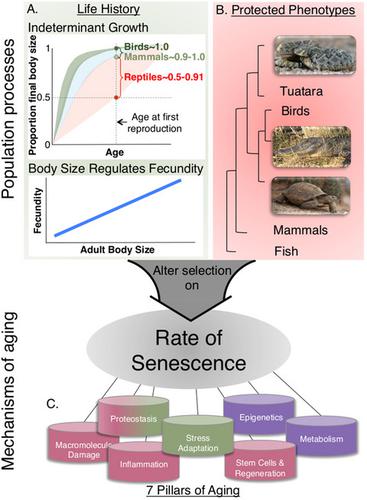当前位置:
X-MOL 学术
›
Funct. Ecol.
›
论文详情
Our official English website, www.x-mol.net, welcomes your feedback! (Note: you will need to create a separate account there.)
The untapped potential of reptile biodiversity for understanding how and why animals age
Functional Ecology ( IF 5.2 ) Pub Date : 2019-10-15 , DOI: 10.1111/1365-2435.13450 Luke A Hoekstra 1 , Tonia S Schwartz 2 , Amanda M Sparkman 3 , David A W Miller 4 , Anne M Bronikowski 1
Functional Ecology ( IF 5.2 ) Pub Date : 2019-10-15 , DOI: 10.1111/1365-2435.13450 Luke A Hoekstra 1 , Tonia S Schwartz 2 , Amanda M Sparkman 3 , David A W Miller 4 , Anne M Bronikowski 1
Affiliation

|
1. The field of comparative aging biology has greatly expanded in the past 20 years. Longitudinal studies of populations of reptiles with a range of maximum lifespans have accumulated and been analyzed for evidence of mortality senescence and reproductive decline. While not as well represented in studies of amniote senescence, reptiles have been the subjects of many recent demographic and mechanistic studies of the biology of aging. 2. We review recent literature on reptile demographic senescence, mechanisms of senescence, and identify unanswered questions. Given the ecophysiological and demographic diversity of reptiles, what is the expected range of reptile senescence rates? Are known mechanisms of aging in reptiles consistent with canonical hallmarks of aging in model systems? What are the knowledge gaps in our understanding of reptile aging? 3. We find ample evidence of increasing mortality with advancing age in many reptiles. Testudines stand out as slower aging than other orders, but data on crocodilians and tuatara are sparse. Sex-specific analyses are generally not available. Studies of female reproduction suggest that reptiles are less likely to have reproductive decline with advancing age than mammals. 4. Reptiles share many physiological and molecular pathways of aging with mammals, birds, and laboratory model organisms. Adaptations related to stress physiology coupled with reptilian ectothermy suggest novel comparisons and contrasts that can be made with canonical aging phenotypes in mammals. These include stem cell and regeneration biology, homeostatic mechanisms, IIS/TOR signaling, and DNA repair. 5. To overcome challenges to the study of reptile aging, we recommend extending and expanding long-term monitoring of reptile populations, developing reptile cell lines to aid cellular biology, conducting more comparative studies of reptile morphology and physiology sampled along relevant life-history axes, and sequencing more reptile genomes for comparative genomics. Given the diversity of reptile life histories and adaptations, achieving these directives will likely greatly benefit all aging biology.
中文翻译:

爬行动物生物多样性的未开发潜力在了解动物衰老的方式和原因方面
1. 比较衰老生物学领域在过去的 20 年中得到了极大的扩展。对具有最大寿命范围的爬行动物种群的纵向研究已经积累并被分析以寻找死亡衰老和生殖衰退的证据。虽然在羊膜衰老的研究中没有得到很好的体现,但爬行动物一直是许多最近衰老生物学的人口统计学和机制研究的主题。2. 我们回顾了最近关于爬行动物人口衰老、衰老机制的文献,并确定了未解决的问题。鉴于爬行动物的生态生理和人口多样性,爬行动物衰老率的预期范围是多少?爬行动物的已知衰老机制是否与模型系统中衰老的典型标志一致?我们对爬行动物衰老的理解存在哪些知识差距?3. 我们发现了许多爬行动物随着年龄的增长死亡率增加的充分证据。Testudines 比其他命令的老化速度更慢,但关于鳄鱼和 tuatara 的数据很少。性别特异性分析通常不可用。对雌性生殖的研究表明,与哺乳动物相比,爬行动物随着年龄的增长而出现生殖衰退的可能性较小。4. 爬行动物与哺乳动物、鸟类和实验室模式生物共享许多衰老的生理和分子途径。与压力生理学相关的适应加上爬行动物的变温表明可以与哺乳动物的典型衰老表型进行新的比较和对比。这些包括干细胞和再生生物学、稳态机制、IIS/TOR 信号传导和 DNA 修复。5. 克服爬行动物衰老研究的挑战,我们建议扩大和扩大对爬行动物种群的长期监测,开发爬行动物细胞系以帮助细胞生物学,对沿相关生活史轴采样的爬行动物形态学和生理学进行更多比较研究,并为比较基因组学对更多爬行动物基因组进行测序。鉴于爬行动物生活史和适应的多样性,实现这些指令可能会极大地有益于所有衰老生物学。
更新日期:2019-10-15
中文翻译:

爬行动物生物多样性的未开发潜力在了解动物衰老的方式和原因方面
1. 比较衰老生物学领域在过去的 20 年中得到了极大的扩展。对具有最大寿命范围的爬行动物种群的纵向研究已经积累并被分析以寻找死亡衰老和生殖衰退的证据。虽然在羊膜衰老的研究中没有得到很好的体现,但爬行动物一直是许多最近衰老生物学的人口统计学和机制研究的主题。2. 我们回顾了最近关于爬行动物人口衰老、衰老机制的文献,并确定了未解决的问题。鉴于爬行动物的生态生理和人口多样性,爬行动物衰老率的预期范围是多少?爬行动物的已知衰老机制是否与模型系统中衰老的典型标志一致?我们对爬行动物衰老的理解存在哪些知识差距?3. 我们发现了许多爬行动物随着年龄的增长死亡率增加的充分证据。Testudines 比其他命令的老化速度更慢,但关于鳄鱼和 tuatara 的数据很少。性别特异性分析通常不可用。对雌性生殖的研究表明,与哺乳动物相比,爬行动物随着年龄的增长而出现生殖衰退的可能性较小。4. 爬行动物与哺乳动物、鸟类和实验室模式生物共享许多衰老的生理和分子途径。与压力生理学相关的适应加上爬行动物的变温表明可以与哺乳动物的典型衰老表型进行新的比较和对比。这些包括干细胞和再生生物学、稳态机制、IIS/TOR 信号传导和 DNA 修复。5. 克服爬行动物衰老研究的挑战,我们建议扩大和扩大对爬行动物种群的长期监测,开发爬行动物细胞系以帮助细胞生物学,对沿相关生活史轴采样的爬行动物形态学和生理学进行更多比较研究,并为比较基因组学对更多爬行动物基因组进行测序。鉴于爬行动物生活史和适应的多样性,实现这些指令可能会极大地有益于所有衰老生物学。



























 京公网安备 11010802027423号
京公网安备 11010802027423号